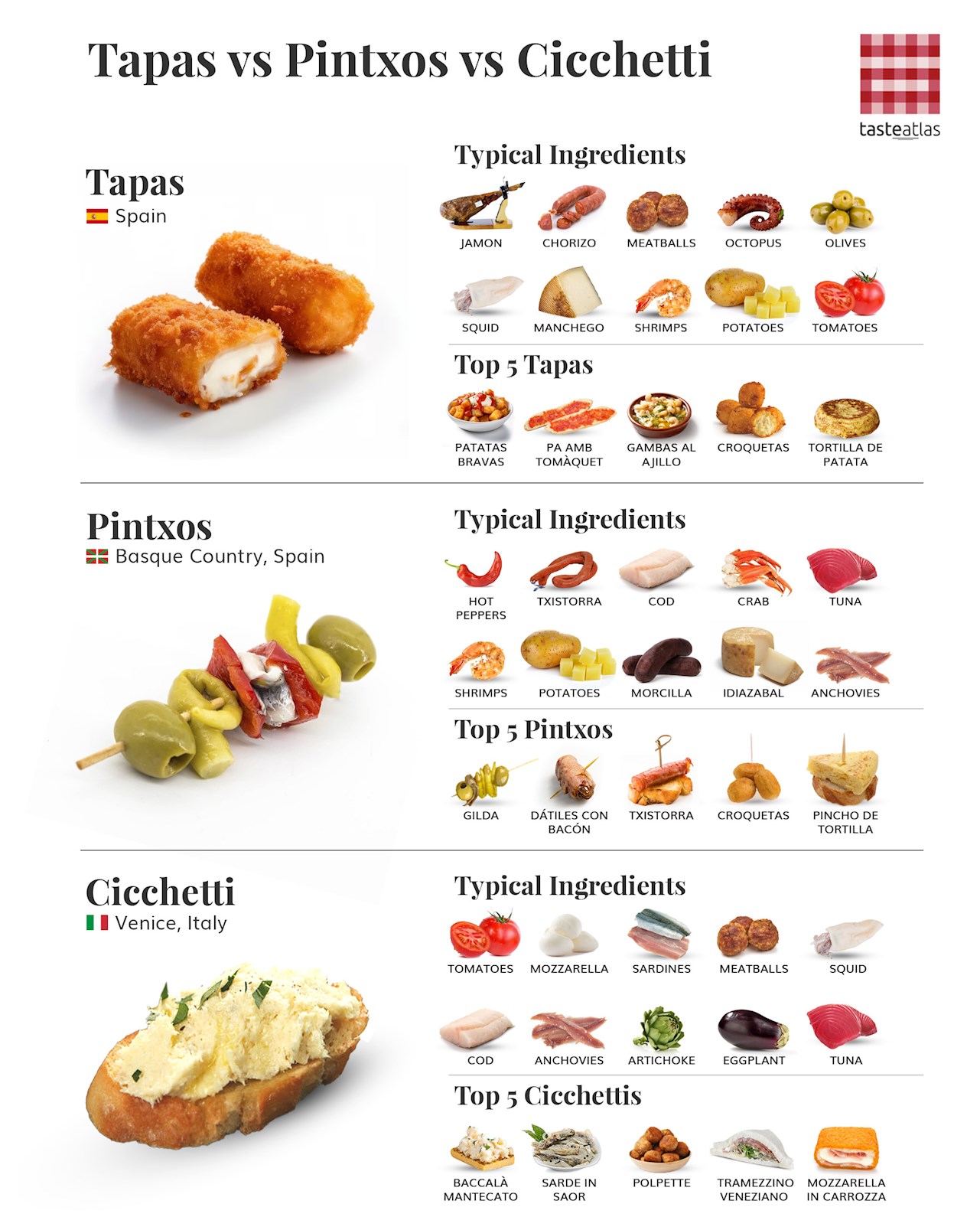Across the diverse culinary landscapes of Europe, small bites with big flavors have captivated the palates of both locals and tourists alike. Tapas, originating from the sun-drenched taverns of Spain, embody the spirit of communal dining and vibrant flavors. Meanwhile, in the northern Basque region, pintxos elevate these bite-sized dishes to an art form, skewered and beautifully presented. Venturing to Italy, to the romantic canals of Venice, cicchetti offer a taste of Italian tradition, celebrating local ingredients with every nibble.
Each of these traditions encapsulates a shared ethos: the joy of communal eating and the celebration of local flavors. And each of them brings something unique to and on the table.
TAPAS
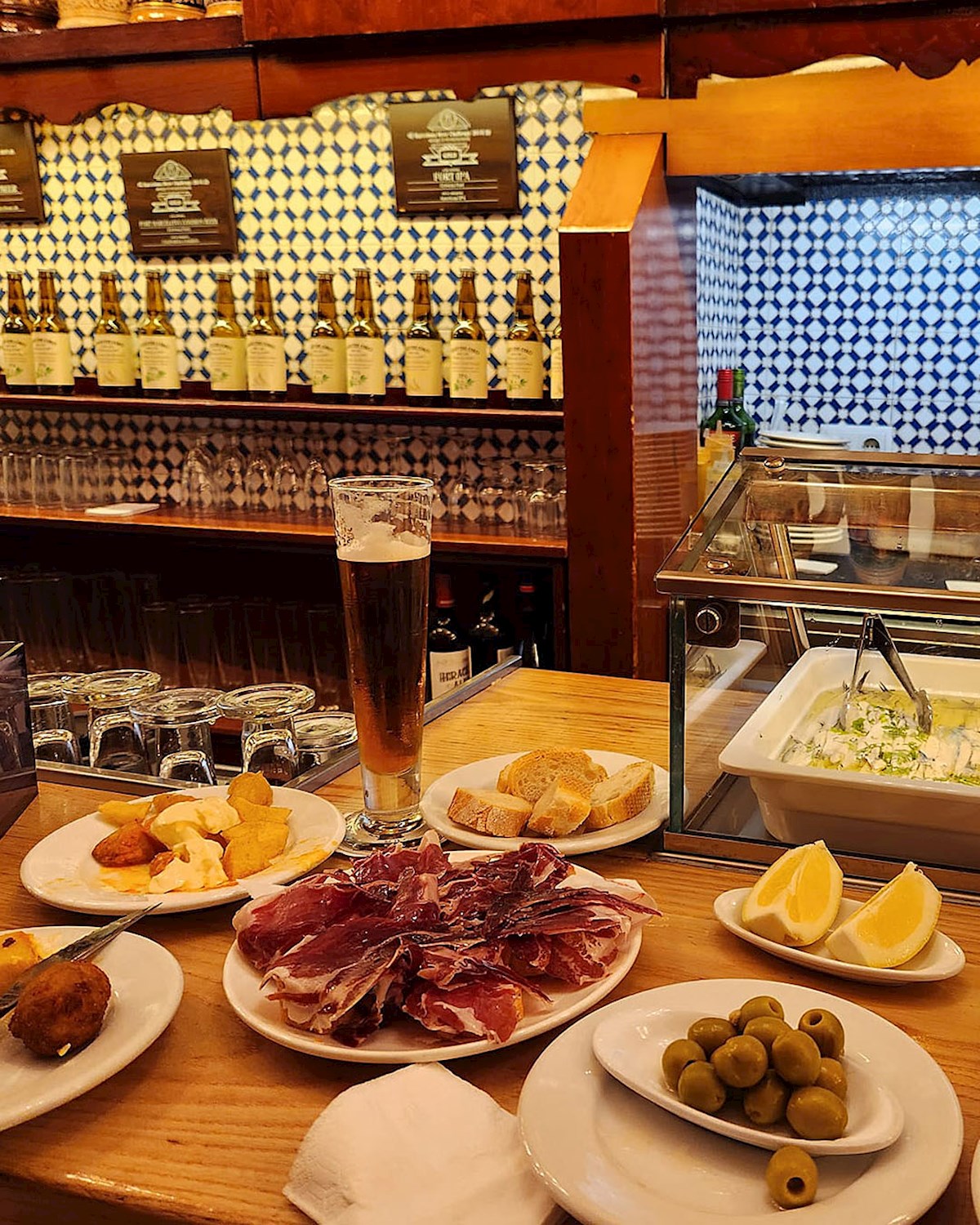 Credits: El Vaso De Oro
Credits: El Vaso De Oro
Tapas are small Spanish savory dishes, typically served with drinks at bars in Spain. These delightful bites can be found in every corner of the country, from bustling city taverns to seaside cafes, and their diversity reflects the rich tapestry of Spanish (regional) cuisine and culture.
The word 'tapa' translates to 'lid' or 'cover' in Spanish. While the precise origins of tapas are steeped in folklore, a popular legend credits King Alfonso X of Castile. After falling ill, he was prescribed small bites of food with wine. Once recovered, he decreed that wine should always be served with a small snack. Another tale claims tapas started when King Alfonso XIII visited a famous tavern in the windy city of Cádiz, and the waiter covered his glass with a slice of ham, to protect it from the blowing beach sand. The king liked the snack with his wine, so he ordered another round "con la tapa" (with the cover).
Regardless of their true origin, tapas have evolved over centuries from simple bread or meat slices to an intricate culinary tradition. They can be practically anything, from a chunk of tuna, cocktail onion, and an olive skewered on a long toothpick to piping hot chorizo sausage served in a small clay dish, or a slice of Spanish omelette. They can be very simple or quite elaborate, depending on the venue and region of Spain.
Traditionally, a cold, crisp Albariño or Verdejo white wine is chosen to complement seafood-based tapas, offering a light and refreshing counterpoint. For meatier or heartier choices, robust Tempranillo or Garnacha red wines can accentuate the dish's depth. Dry sherries, particularly Fino and Manzanilla, are often the go-to for olives, almonds, and lighter fare, introducing a nuanced complexity. Meanwhile, Cava, Spain's signature sparkling wine, stands out as a versatile option, adding a bubbly delight to anything from fried croquetas to tangy cheeses.
While traditional tapas remain beloved, there's a new wave of innovative tapas that fuse traditional ingredients with international flavors. Chefs are experimenting, making tapas that are not just tasty but also visually stunning, turning them into works of culinary art.
Tapas are not just about the food; they're also a social institution. They cater to the Spanish custom of enjoying food leisurely and in good company. Spaniards often "ir de tapas" (go for tapas), hopping from one establishment to another, sampling dishes and enjoying drinks. This practice emphasizes conversation, camaraderie, and community.
In recent years, tapas bars have gained popularity worldwide. These establishments, both in and outside of Spain, offer a range of traditional and contemporary tapas, bringing the Spanish tradition to global audiences.
BEST PLACES TO TRY TAPAS
• El Rinconcillo
• Quimet y Quimet
• El Xampanyet
• Cal Pep
• El Vaso de Oro
MOST POPULAR TAPAS
Gambas al ajillo
 Credits: La Casa del Abuelo
Credits: La Casa del Abuelo
Gambas al ajillo, or garlic shrimps, is a classic Spanish dish of succulent shrimps sautéed in olive oil and infused with copious amounts of garlic, often accented with a hint of chili for a subtle kick. The dish is typically served sizzling in a clay pot or cazuela, with the flavorful oil that becomes a treat in itself, perfect for dipping with fresh crusty bread.
TasteAtlas score: 4.6
Learn more about Gambas al ajillo
Croquetas
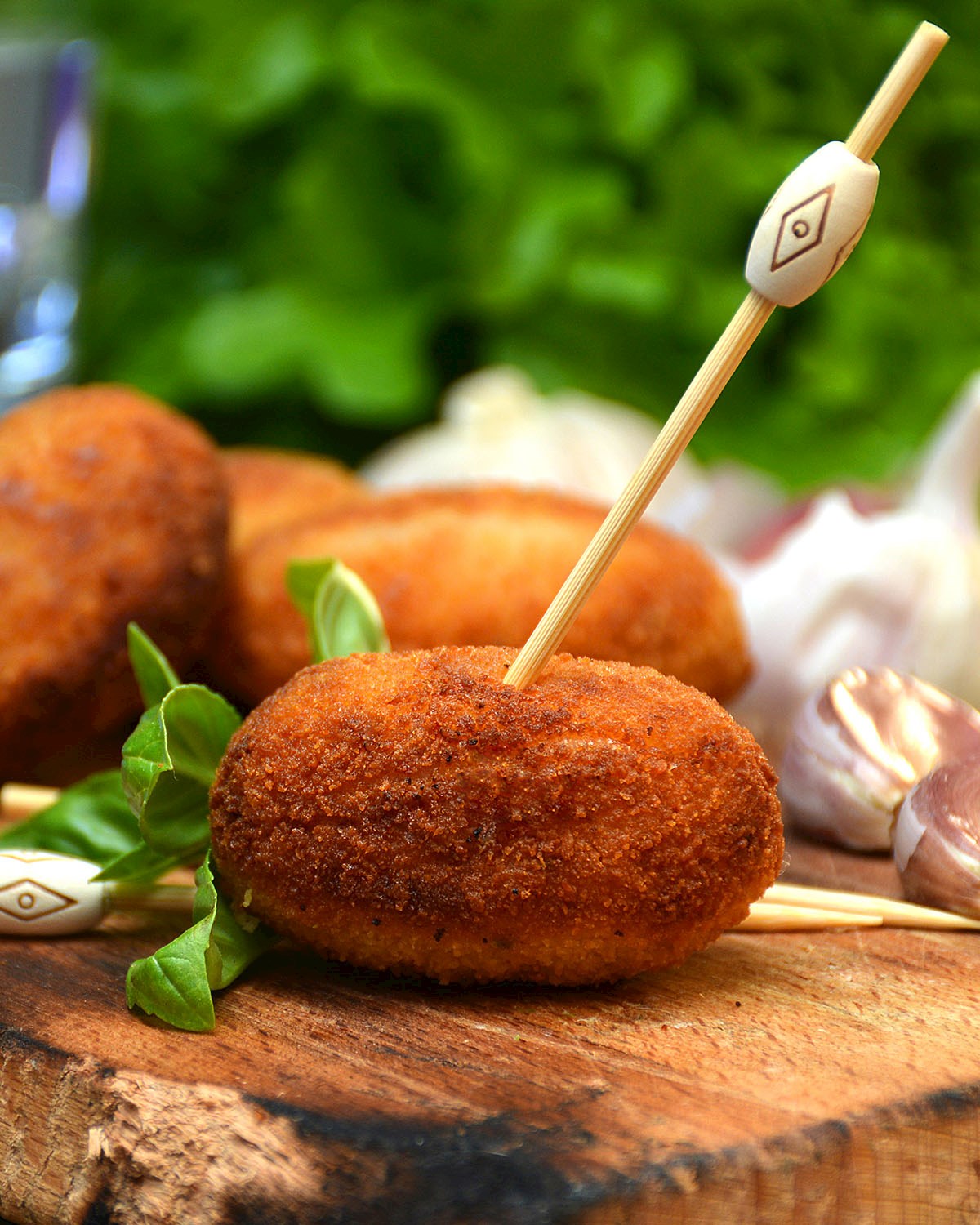 Credits: shutterstock
Credits: shutterstock
Croquetas are a popular Spanish snack made of a thick béchamel sauce mixed with various fillings like ham, chicken, or fish. These bite-sized delights are breaded and deep-fried, offering a creamy interior contrasted by a crispy exterior.
TasteAtlas score: 4.5
Pulpo a la gallega
 Credits: shutterstock
Credits: shutterstock
Pulpo a la gallega, also known as "polbo á feira" in Galician, is a traditional dish from the Galicia region of Spain. The dish showcases tender octopus that is boiled, typically in a copper cauldron, until it reaches the perfect texture. Once cooked, the octopus is sliced into thin pieces, seasoned generously with paprika, coarse sea salt, and drizzled with olive oil.
TasteAtlas score: 4.5
Learn more about Pulpo a la gallega
Gambas à la plancha
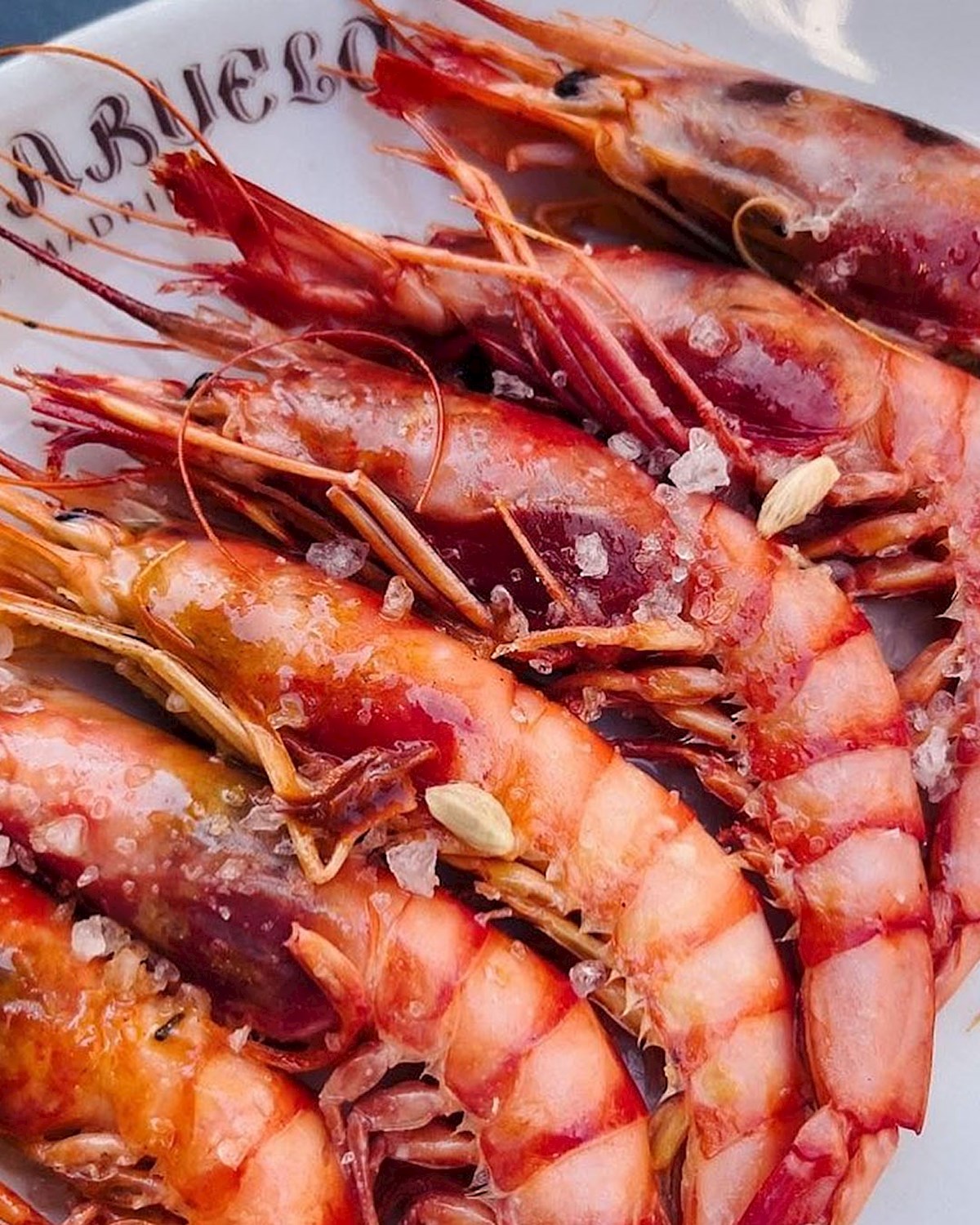 Credits: La Casa del Abuelo
Credits: La Casa del Abuelo
Gambas à la plancha is a traditional Spanish dish that is beautifully simple to prepare: fresh shrimps are seasoned with salt and then quickly grilled or seared on a hot griddle or skillet, retaining their natural flavors. As they cook, shrimps take on a charred exterior while remaining succulent inside, and are often served straight from the grill with a squeeze of lemon.
TasteAtlas score: 4.5
Learn more about Gambas à la plancha
Rabas
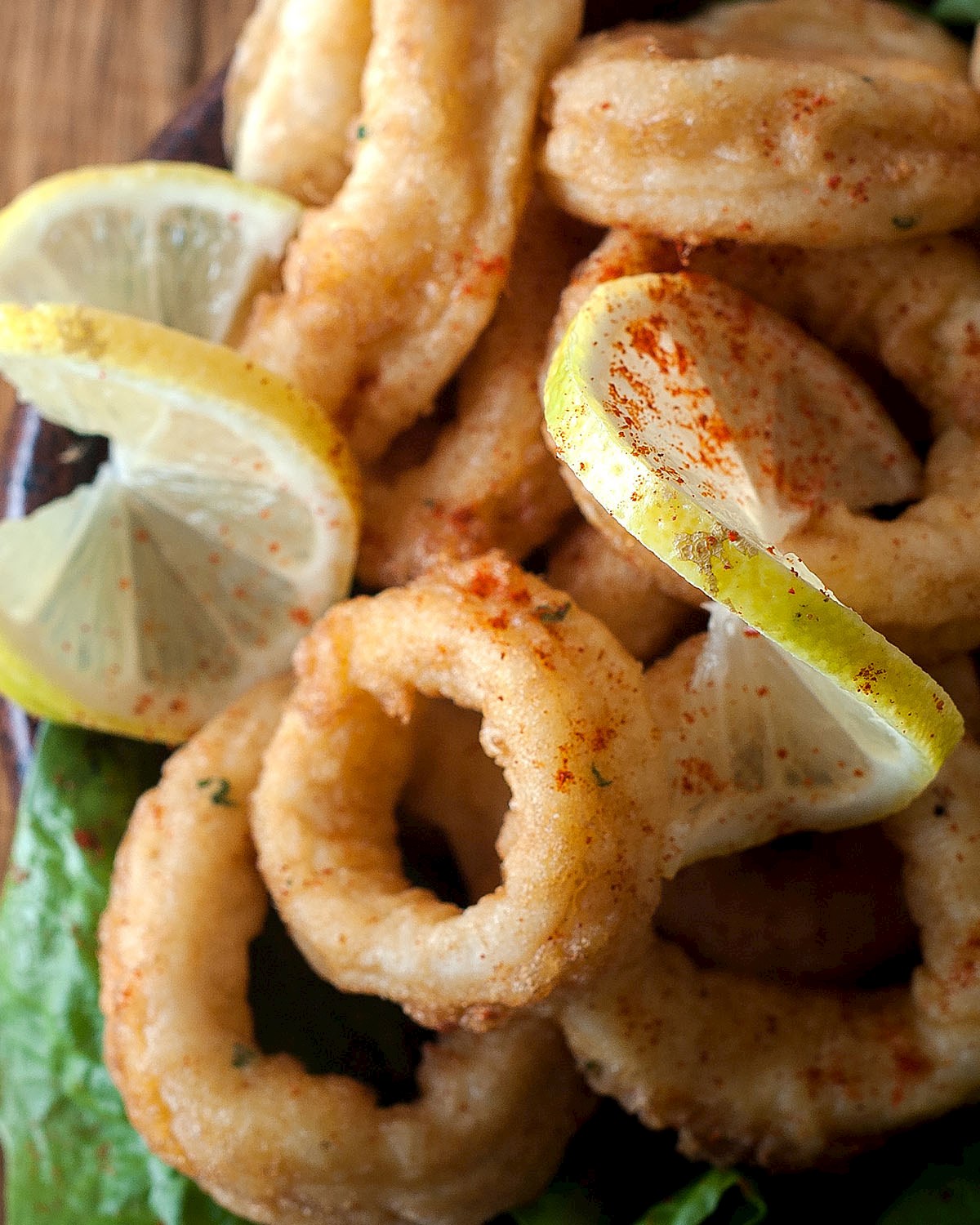 Credits: shutterstock
Credits: shutterstock
Rabas are a popular snack in Spain, particularly in the northern regions like Cantabria. Essentially, they are squid rings, similar to calamari, that are lightly battered and deep-fried until they achieve a golden and crispy exterior. Often seasoned simply with a sprinkle of salt, rabas are enjoyed for their tender meat juxtaposed with the crunchy batter.
TasteAtlas score: 4.4
Montaditos
 Credits: 100 Montaditos
Credits: 100 Montaditos
Montaditos are small, flavorful sandwiches that hail from Spain, particularly popular in the southern region of Andalusia. These bite-sized delights typically feature a variety of ingredients, from meats like jamón and chorizo to seafood and cheeses, all layered atop a slice of crusty bread.
TasteAtlas score: 4.4
Tortilla de patata
 Credits: shutterstock
Credits: shutterstock
Tortilla de patata, often referred to as a Spanish omelette, is a dish made primarily from eggs, potatoes, and occasionally onions, cooked until set and resulting in a thick, round omelette. The texture contrasts between the soft, layered potatoes inside and the golden exterior make it uniquely satisfying, and it can be enjoyed both hot and cold.
TasteAtlas score: 4.3
Learn more about Tortilla de patata
Patatas bravas
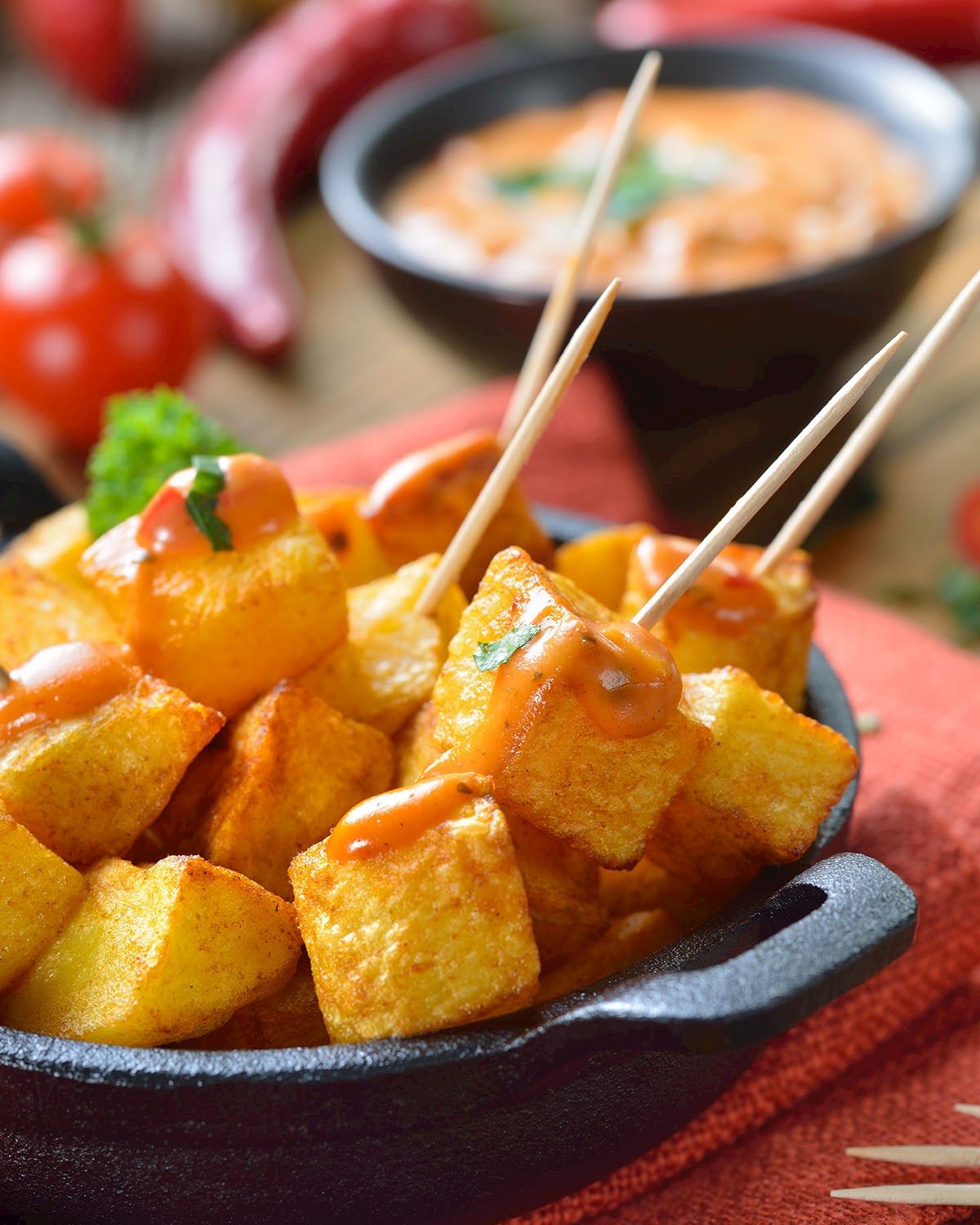 Credits: shutterstock
Credits: shutterstock
Patatas bravas are a beloved Spanish dish consisting of cubed or wedge-cut potatoes that are deep-fried until golden and crunchy on the outside while remaining soft inside, after which they are drizzled or served with "salsa brava", a tangy, spicy tomato-based sauce.
TasteAtlas score: 4.3
Learn more about Patatas bravas
Pa amb tomàquet
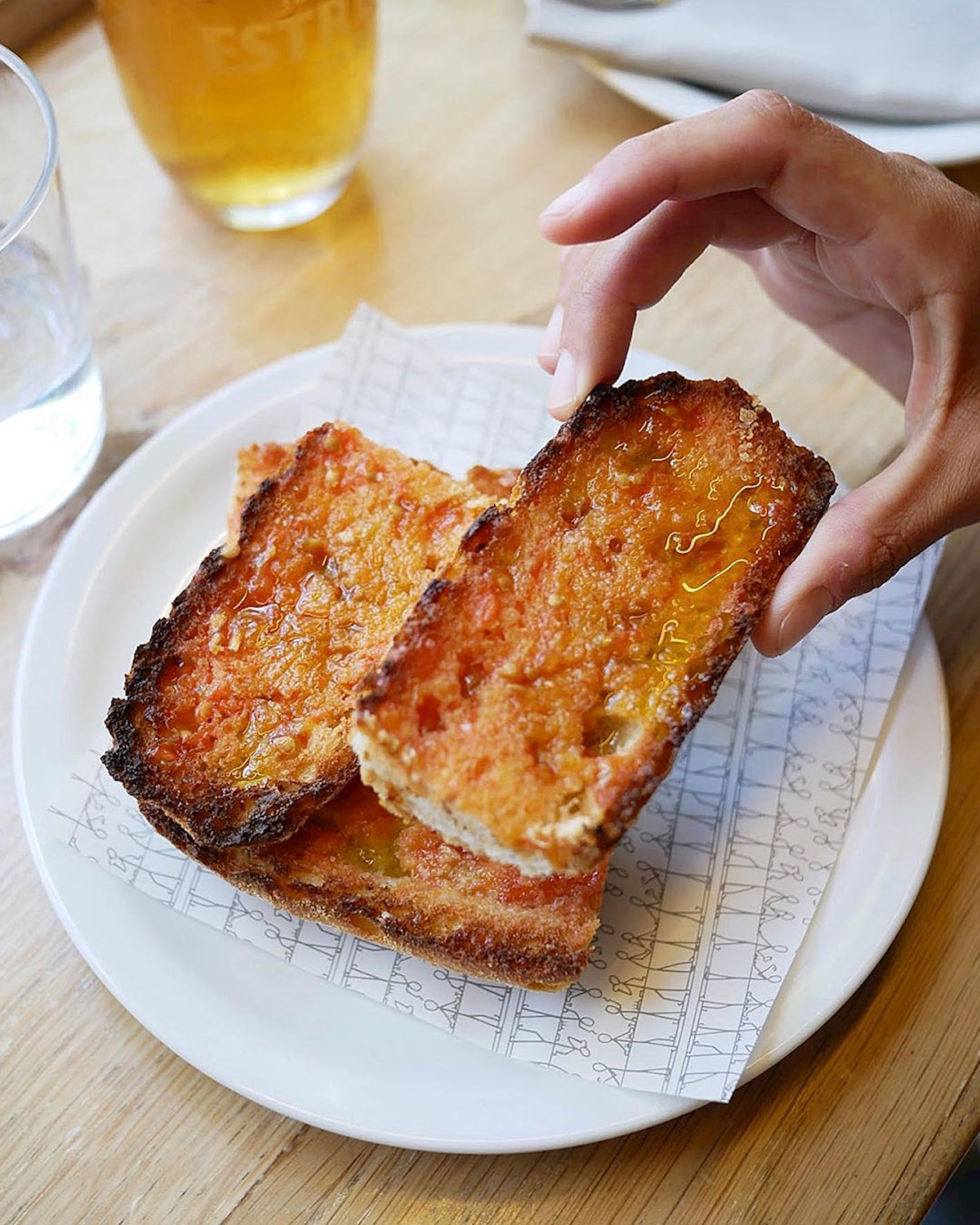 Credits: PacoMeralgo
Credits: PacoMeralgo
Pa amb tomàquet, which translates to "bread with tomato," is a quintessential Catalan dish deeply rooted in the culinary traditions of the region. The preparation involves rubbing ripe tomatoes over crusty bread, which soaks up the tomato's juice and pulp. The bread is then drizzled with olive oil, and seasoned with garlic and a pinch of salt, creating a harmonious blend of flavors.
TasteAtlas score: 4.3
Learn more about Pa amb tomàquet
Albóndigas en salsa
 Credits: shutterstock
Credits: shutterstock
Albóndigas en salsa refers to Spanish meatballs in sauce, a dish cherished across Spain and its various regions. These meatballs, made from a mixture of ground meat, breadcrumbs, and spices, are browned and then simmered in a rich sauce, often tomato-based with various seasonings. The sauce can vary by region, with some incorporating almond-based gravies, white wine, or even saffron-infused broths.
TasteAtlas score: 4.3
Learn more about Albóndigas en salsa
PINTXOS
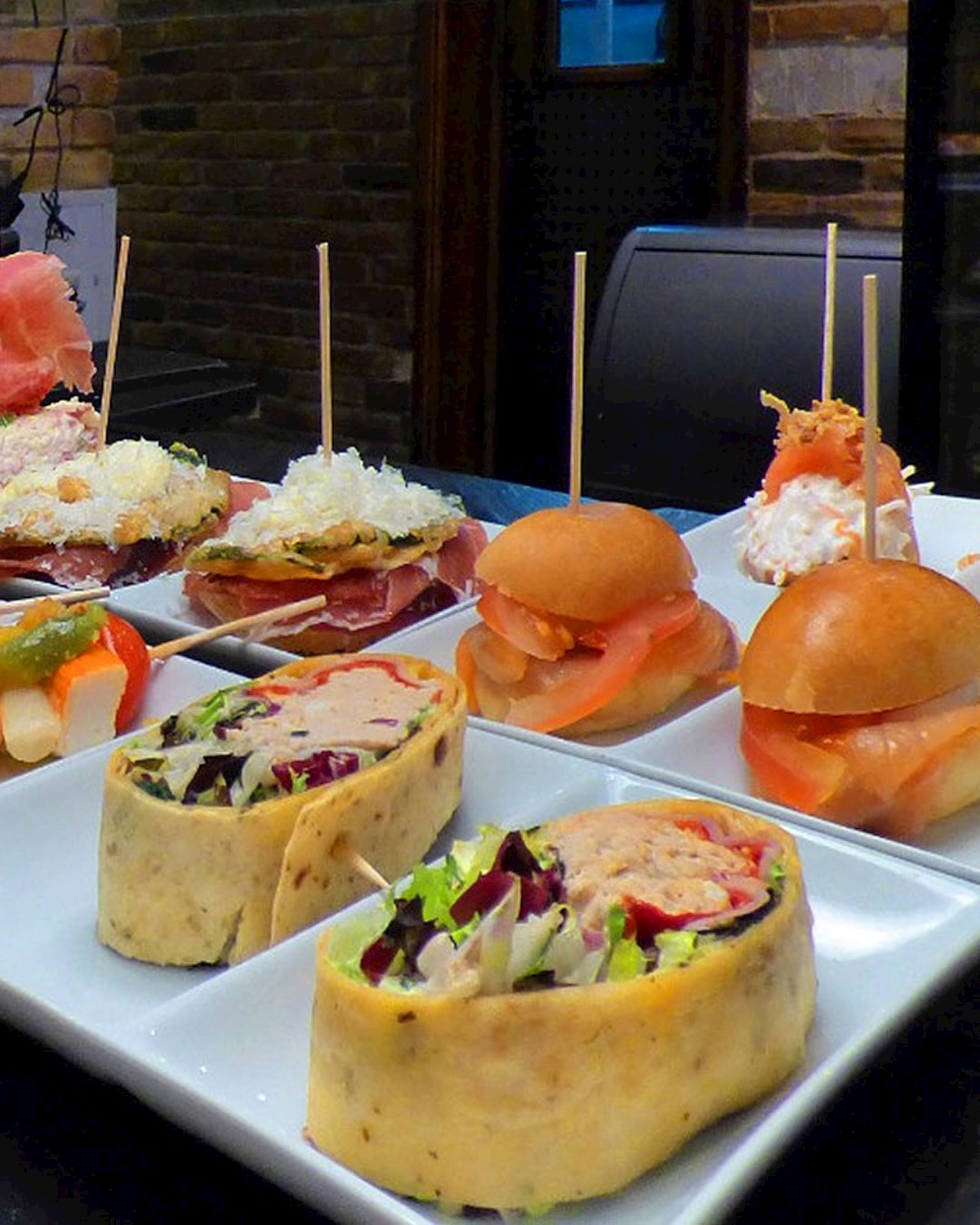 Credits: Tast Unión
Credits: Tast Unión
In the vibrant tapestry of Spanish gastronomy, pintxos (or pinchos, as they are known in the rest of the country) hold a special place. These bite-sized delights have evolved from humble bar snacks into intricate culinary creations that draw food lovers from around the world to the narrow streets of San Sebastián, Bilbao, and other Basque towns.
The word 'pintxo' is derived from the Spanish verb "pinchar," meaning "to pierce" or "to stab," which is fitting given the skewer or toothpick that often (but not always) holds these snacks together. While pintxos are enjoyed primarily in the Basque Country, pinchos are a common snack in the neighboring regions of Navarre, Cantabria, and La Rioja. And it's not just the slight difference in the name that matters: pinchos from each region uphold certain culinary traditions and have grown to reflect that region's unique ingredients, flavors, and aesthetics.
Pintxos are usually served pierced with a skewer or a toothpick, or on a slice of baguette acting as a foundation for a variety of toppings. Some are simple, with only one or two ingredients, while others are miniature culinary masterpieces, showcasing layer upon layer of flavor and texture.
The range of pintxos is astounding. From fresh seafood to cured meats, from seasonal vegetables to regional cheeses, the options are limited only by the availability of the ingredients and the chef's creativity. Pintxos bars present an array of these snacks on counters, enticing customers with their visual appeal. Patrons usually select the pintxos they want and then pay based on the number of skewers or toothpicks they've accumulated.
A glass of Txakoli, the slightly sparkling and tart white wine from the region, pairs delightfully with seafood-based pintxos, offering a refreshing palate cleanser. For richer, meat-centered pintxos, a Rioja—whether red or white—can provide the depth and body to match the dish's intensity. Sidra, or Basque cider, with its natural, sour profile, offers a unique pairing, especially for pintxos featuring cheeses or charcuterie.
Pintxos are emblematic of the Basque Country, offering a window into its rich history, diverse ingredients, and communal spirit. Whether enjoyed in a traditional tavern or a modern gastro-bar, pintxos remain a testament to the region's profound culinary prowess and passion.
BEST PLACES TO TRY PINTXOS
• Borda Berri
• Ganbara
• La Cuchara de San Telmo
• Txepetxa
• Bar Bergara
MOST POPULAR BASQUE PINTXOS
Pincho de tortilla
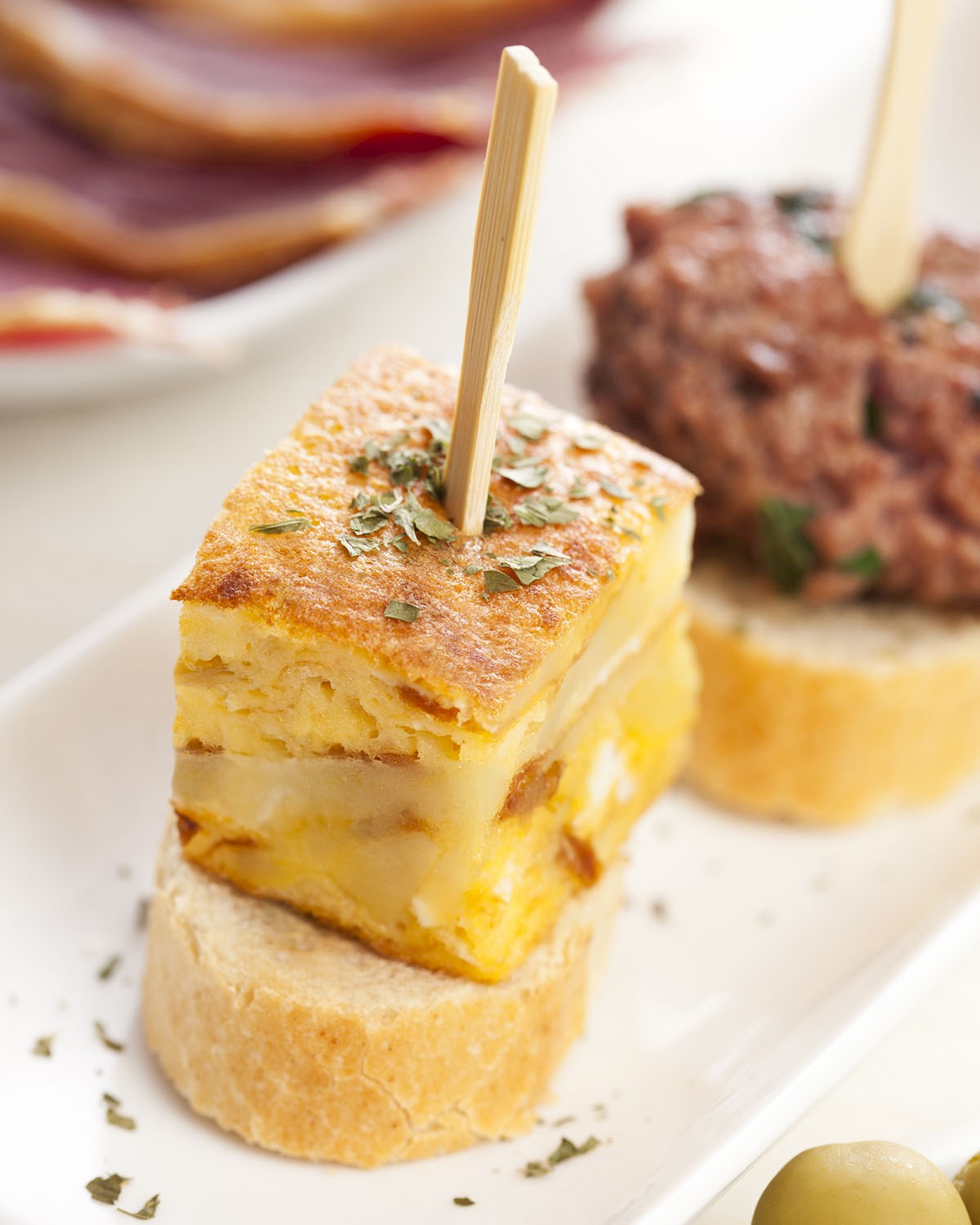 Credits: shutterstock
Credits: shutterstock
Pincho de tortilla is a traditional Basque appetizer or bar snack, typically consisting of a generous wedge of tortilla de patata, made primarily from eggs, potatoes, and sometimes onions, served atop a slice of crusty bread.
TasteAtlas score: 4.5
Learn more about Pincho de tortilla
Pincho de croquetas
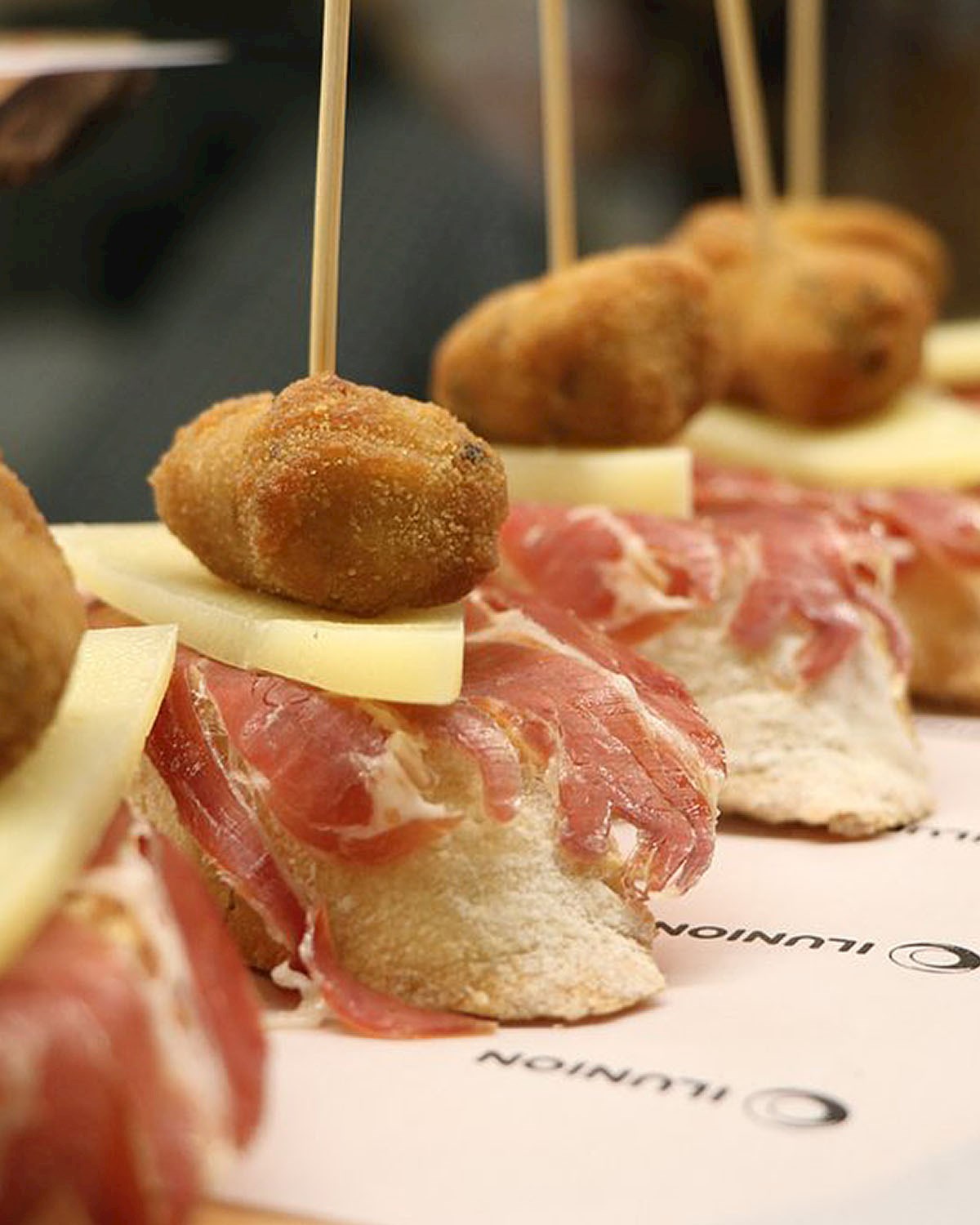 Credits: La Kedada Restaurante
Credits: La Kedada Restaurante
Pincho de croquetas introduces a delightful fusion of Spain's love for croquetas and the Basque tradition of pintxos. These small, breaded, and deep-fried bites— filled with béchamel and ingredients like ham, chicken, or cod—are placed atop a slice of crusty bread to form the pincho.
TasteAtlas score: 4.4
Learn more about Pincho de croquetas
Pincho de champiñon
 Credits: shutterstock
Credits: shutterstock
Pincho de champiñon celebrates the earthy flavors of mushrooms, a staple in many Spanish kitchens. This pintxo typically features skewered mushrooms, often marinated and grilled or sautéed, placed atop a slice of crusty bread. Many variations enhance the mushrooms with garlic, parsley, or a splash of white wine.
TasteAtlas score: 3.8
Learn more about Pincho de champiñon
Pincho de pimentos del piquillo rellenos de atún
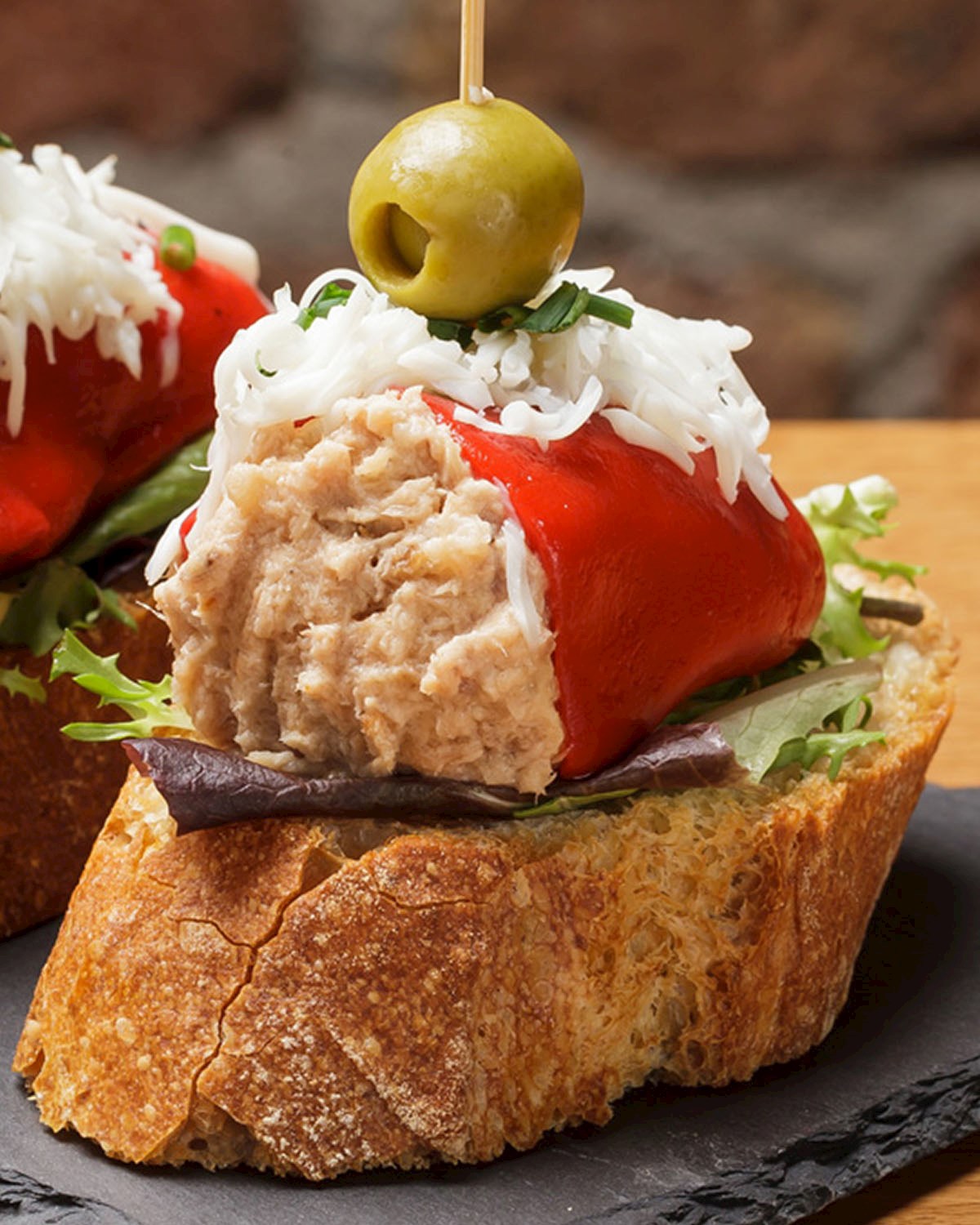 Credits: Taberna Berri
Credits: Taberna Berri
Pincho de pimientos del piquillo rellenos de atún is a flavorful Basque bite that combines the sweet and smoky notes of piquillo peppers with the savory taste of tuna. In this dish, the piquillo peppers, a red, heart-shaped variety from Northern Spain, are skillfully stuffed with a filling predominantly made of tuna, though often mixed with other ingredients like mayonnaise or onions.
TasteAtlas score: 3.4
Learn more about Pincho de pimentos del piquillo rellenos de atún
Pinchos Gilda
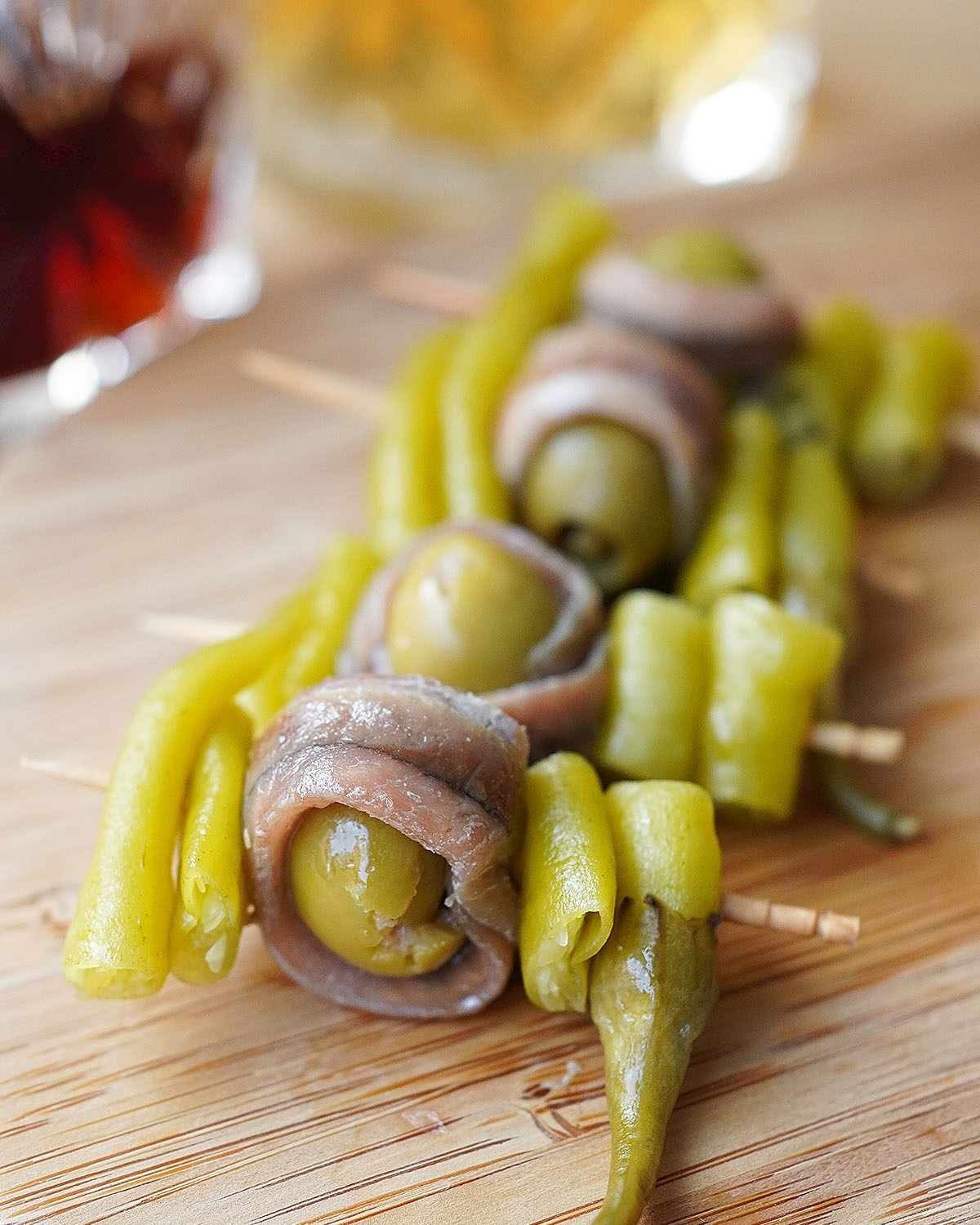 Credits: shutterstock
Credits: shutterstock
Pinchos Gilda stands as one of the most iconic pintxos from the Basque region, embodying simplicity and strong flavors in one bite. Named after Rita Hayworth's character "Gilda" from the 1946 movie due to its "spicy" nature, this pintxo consists of pickled guindilla peppers, green olives, and anchovies skewered together on a stick.
TasteAtlas score: 3.4
Learn more about Pinchos Gilda
Pincho dátiles con bacón
 Credits: shutterstock
Credits: shutterstock
Pincho dátiles con bacón is a delightful fusion of sweet and savory, often skewered and served atop crusty bread. In this dish, dates, with their natural sweetness and chewy texture, are wrapped in thin slices of bacon and then grilled or roasted until crispy.
TasteAtlas score: 3.4
Learn more about Pincho dátiles con bacón
Pincho de cangrejo
 Credits: Sotto Wilmslow
Credits: Sotto Wilmslow
Pincho de cangrejo spotlights the delicate and flavorful world of crab meat, giving diners a taste of the sea in a bite-sized form. This pintxo typically showcases a mound of crab salad, often blended with mayonnaise, herbs, and sometimes a hint of citrus, heaped onto a slice of fresh, crusty bread.
TasteAtlas score: 2.9
Learn more about Pincho de cangrejo
Pincho ensaladilla rusa
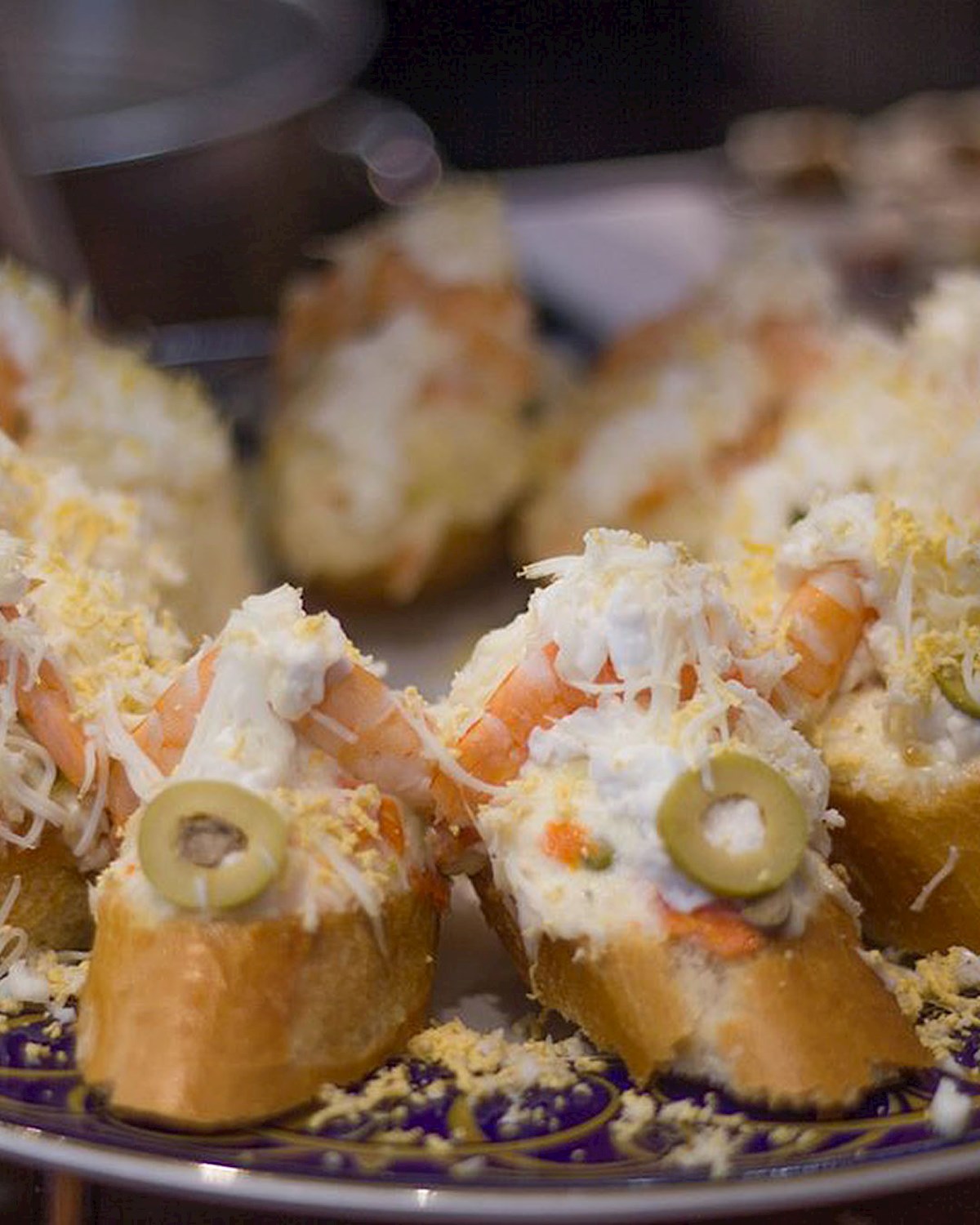 Credits: Bar Gorriti
Credits: Bar Gorriti
Pincho ensaladilla rusa offers a delightful Spanish twist on a classic Russian salad, blending diverse culinary traditions in a singular bite. This pintxo features a creamy mixture of potatoes, carrots, peas, and other vegetables, often bound together with mayonnaise and occasionally punctuated with tuna or hard-boiled eggs. Served atop a slice of crusty bread, the cool and hearty salad contrasts beautifully with the bread's texture, providing a satisfying bite.
TasteAtlas score: 2.8
Learn more about Pincho ensaladilla rusa
Pincho de huevo y gamba
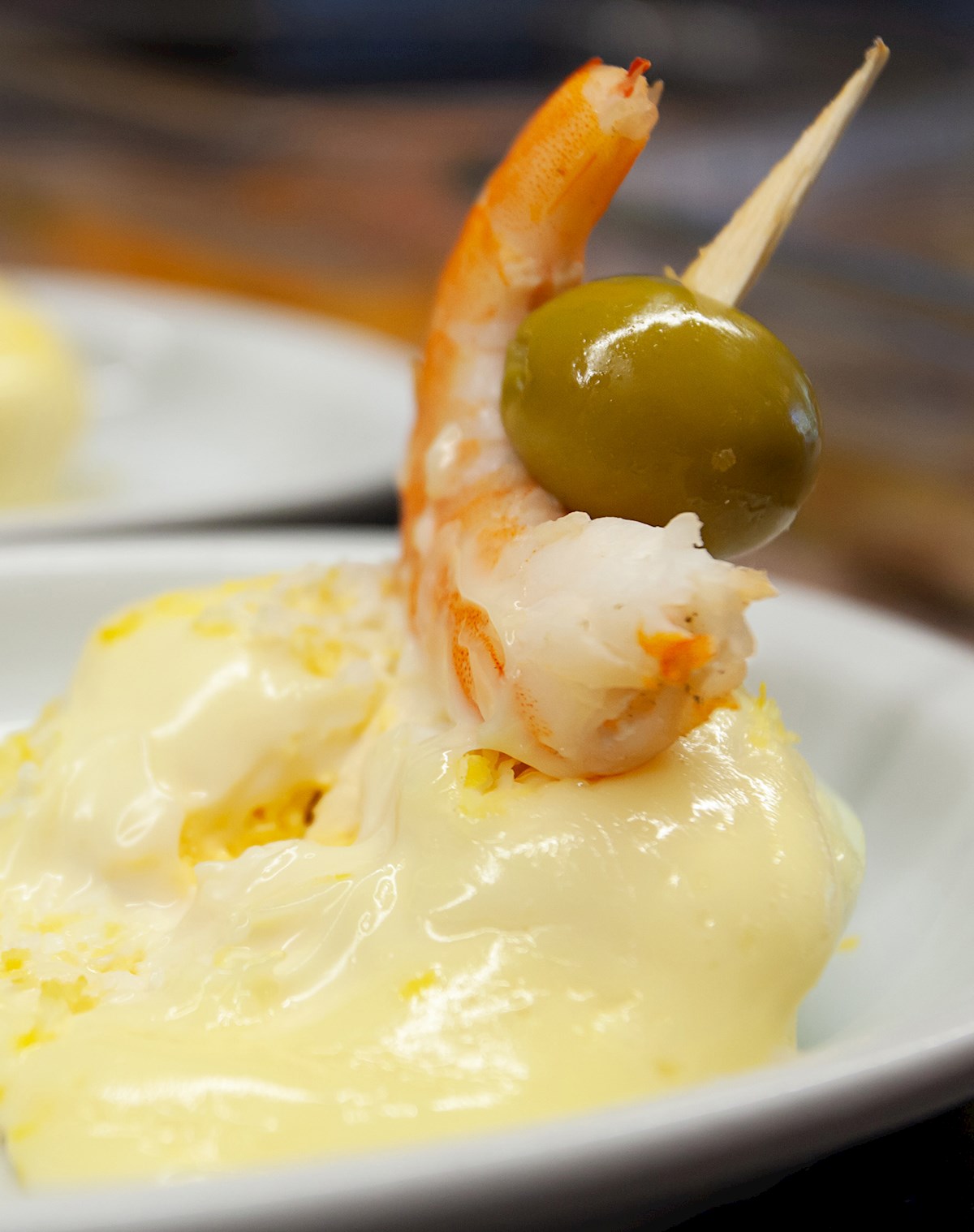 Credits: shutterstock
Credits: shutterstock
Pincho de huevo y gamba is a delightful assembly that combines the delicate flavors of shrimp and egg in traditional Spanish pintxo fashion. Perched atop a slice of crusty bread is often a perfectly cooked quail egg, accompanied by a succulent shrimp, either grilled or sautéed.
TasteAtlas score: N/A
Learn more about Pincho de huevo y gamba
Pincho gambas al ajillo
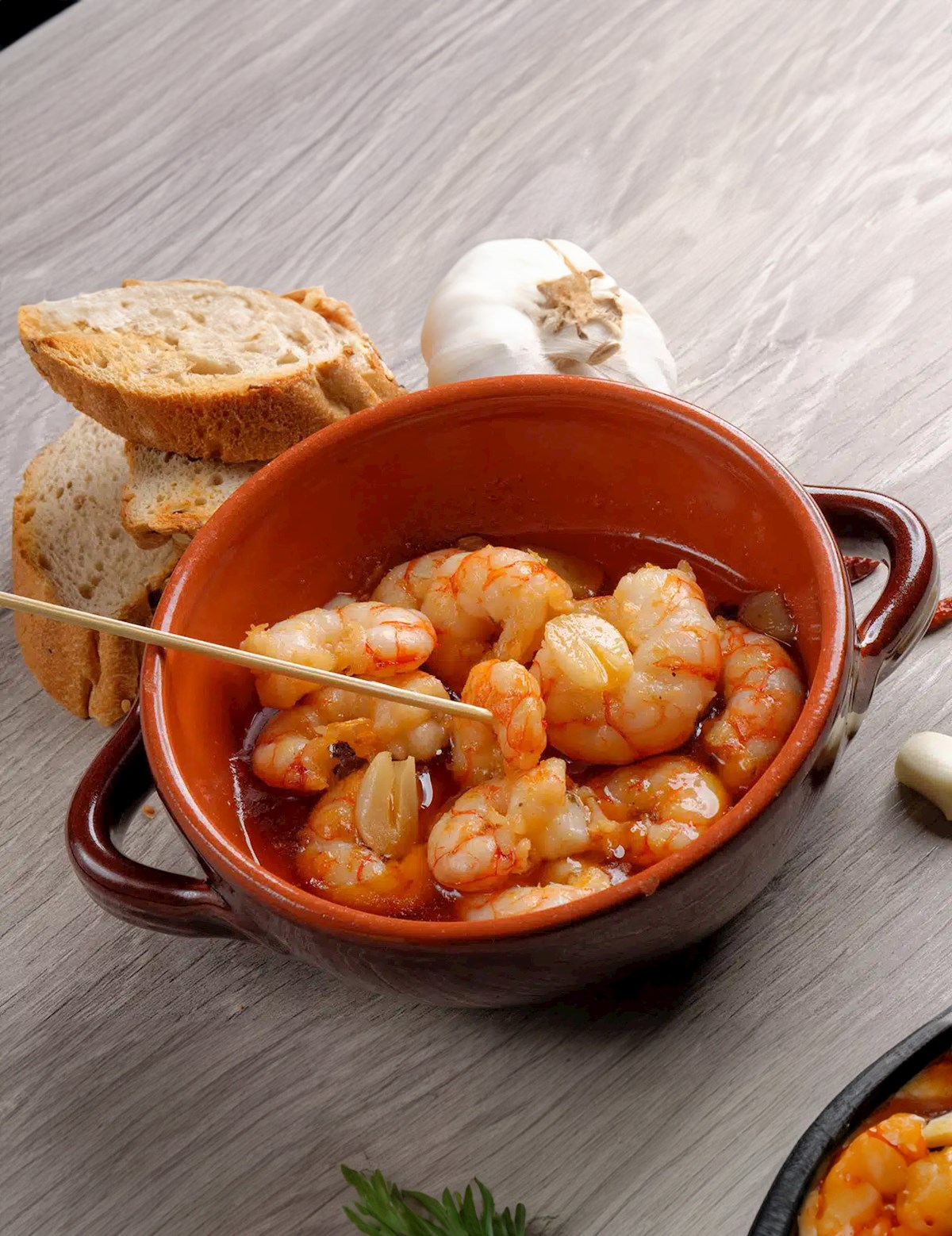 Credits: shutterstock
Credits: shutterstock
Pincho gambas al ajillo elevates the iconic Spanish dish of gambas al ajillo into a bite-sized treat perfect for casual nibbling or festive gatherings. At the heart of this pintxo is succulent shrimp sautéed in a heady mix of olive oil, garlic, and chili. It is then either pierced with a toothpick or placed atop a piece of crusty bread.
TasteAtlas score: N/A
Learn more about Pincho gambas al ajillo
CICCHETTI
 Credits: Enoteca Al Volto
Credits: Enoteca Al Volto
Cicchetti (pronounced "chee-KET-tee") are traditional Venetian appetizers or small snacks. Similar to Spanish tapas or Basque pintxos, cicchetti are an integral part of the local culinary culture in Venice, Italy. They're typically enjoyed with a small glass of local wine, known as an "ombra".
Venice's culinary traditions are shaped by its unique geography. Being a lagoon city, Venice developed a distinct food culture, which includes a fondness for seafood and other local ingredients. Cicchetti are the manifestation of this rich history, often reflecting the bounty of both the lagoon and the surrounding Veneto region.
Cicchetti are deeply tied to Venetian social life. Locals often stop by "bacari" (traditional Venetian bars) for a quick snack and a glass of wine, especially during the early evening before dinner. These establishments are buzzing with activity, filled with patrons engaged in lively conversation while savoring bite-sized delicacies.
An integral part of the cicchetti experience is pairing these snacks with wine. Locals often opt for an "ombra," a small glass of wine. The popular choices include local wines like Prosecco, Soave, or Valpolicella.
Cicchetti are more than just appetizers; they're a reflection of Venice's rich history, its lagoon-centric culture, and its passion for communal gatherings. They showcase the essence of Venetian cuisine: simple ingredients turned into delightful bites. If you ever find yourself wandering the maze-like streets of Venice, stepping into a bacaro for some cicchetti and wine is an experience not to be missed.
BEST PLACES TO TRY CICCHETTI
• All'Arco
• Cà D'Oro alla Vedova
• Cantina del Vino già Schiavi
• Rosticceria Gislon
• Enoteca Al Volto
MOST POPULAR CICCHETTI
Fritto misto
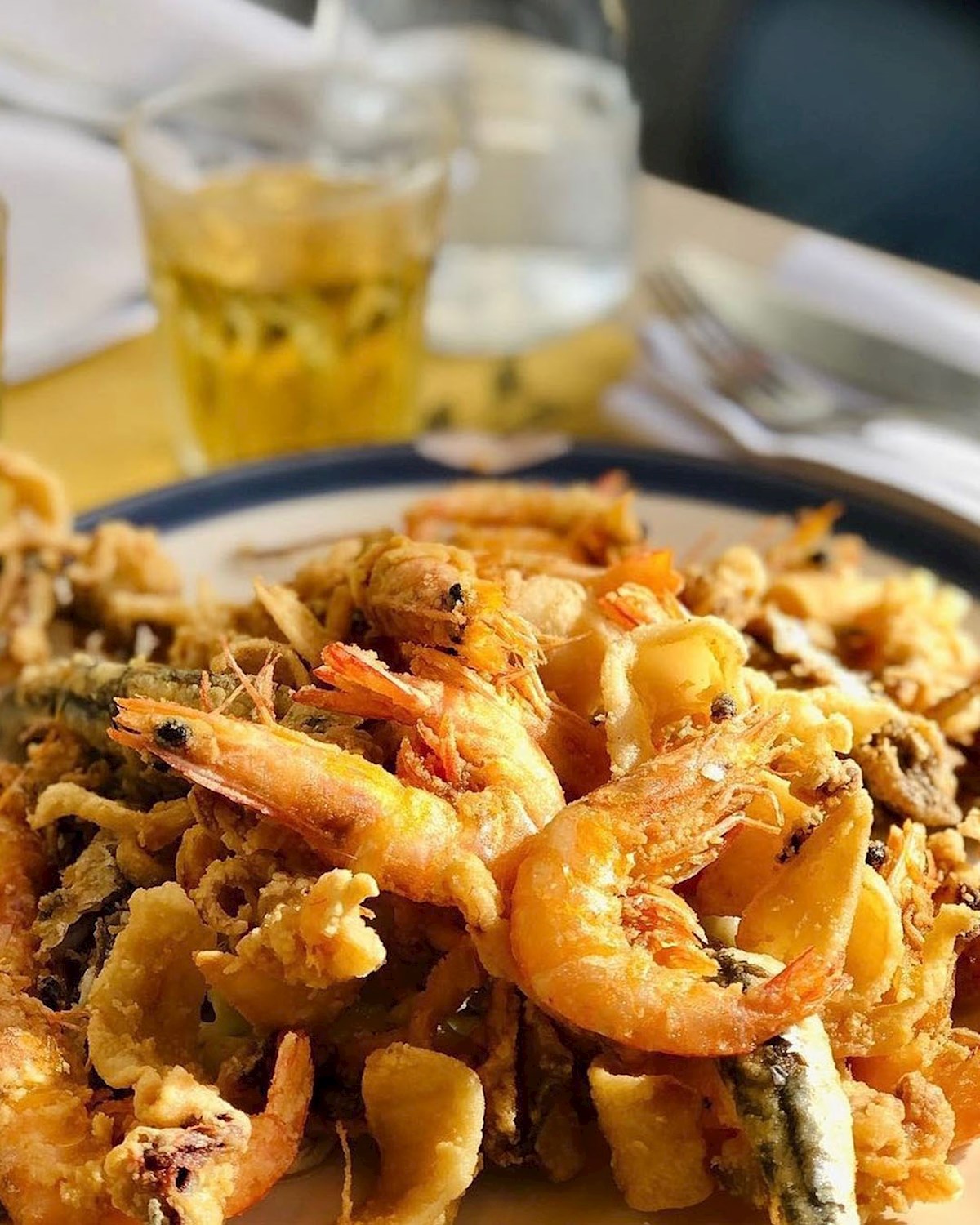 Credits: Pescheria Gallina
Credits: Pescheria Gallina
Fritto misto, which translates to "mixed fry", comprises a medley of seafood—like shrimp, squid, and small fish—alongside select vegetables, all lightly battered and deep-fried to golden perfection. Served traditionally with wedges of lemon and sometimes a simple dipping sauce, fritto misto is a crunchy, savory feast, where each component retains its distinct flavor while harmonizing with the others.
TasteAtlas score: 4.7
Polpette
 Credits: shutterstock
Credits: shutterstock
Served in the city's traditional "bacari" or wine bars, these meatballs are often smaller in size than their main-course counterparts, tailored for easy, bite-sized consumption alongside a glass of wine. While some are drenched in tomato sauce, many Venetian versions are simply fried to a golden crisp, emphasizing the flavorful meat and seasonings.
TasteAtlas score: 4.5
Mozzarella in carrozza
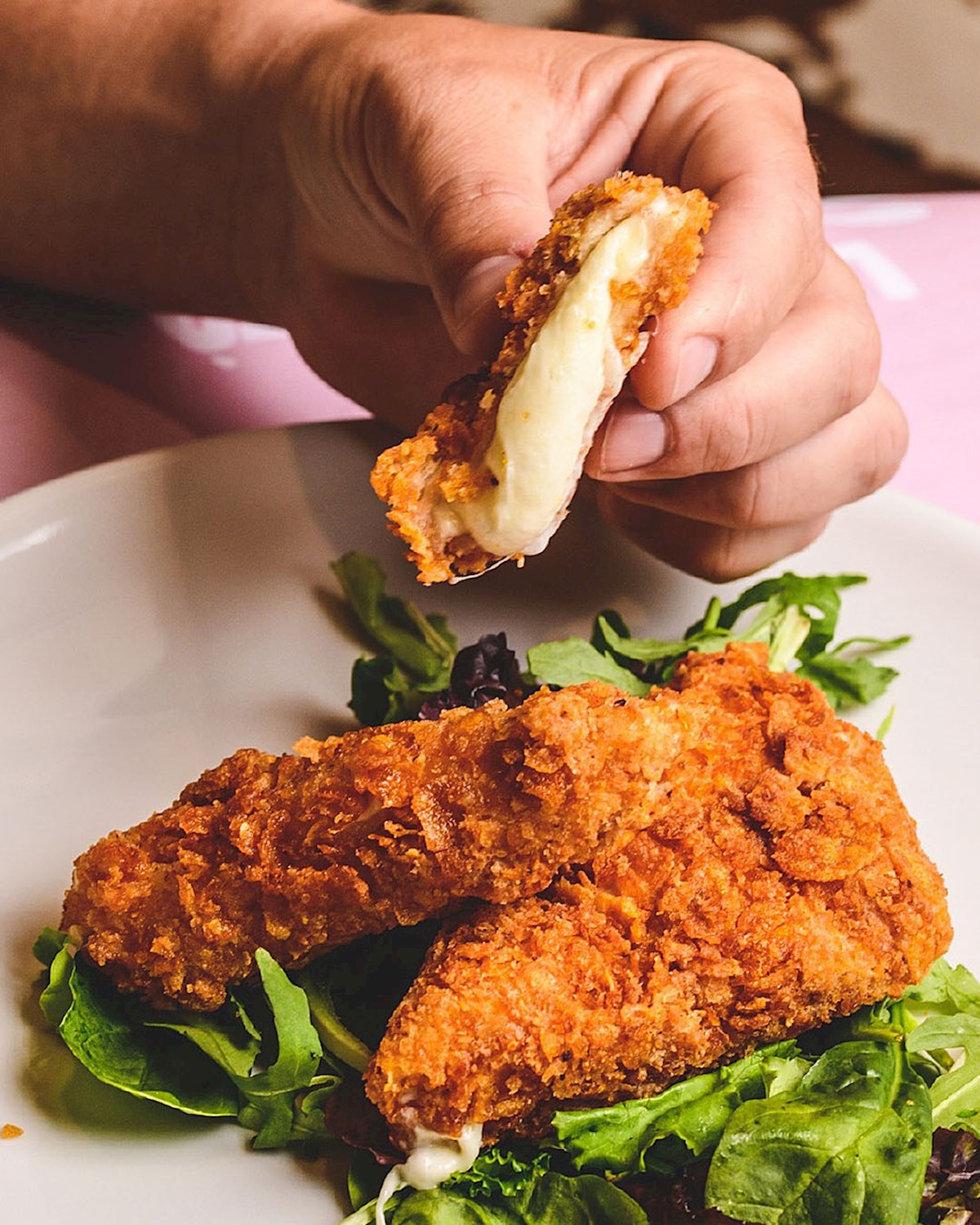 Credits: Muu Mozzarella
Credits: Muu Mozzarella
At its core, mozzarella in carrozza consists of slices of mozzarella cheese sandwiched between pieces of white bread, which are then dipped in a beaten egg mixture, coated in breadcrumbs, and deep-fried to a golden perfection. Often accompanied by the side of marinara sauce for dipping, Mozzarella in carrozza is Italy's luxurious answer to the classic grilled cheese sandwich.
TasteAtlas score: 4.5
Learn more about Mozzarella in carrozza
Bruschetta al pomodoro
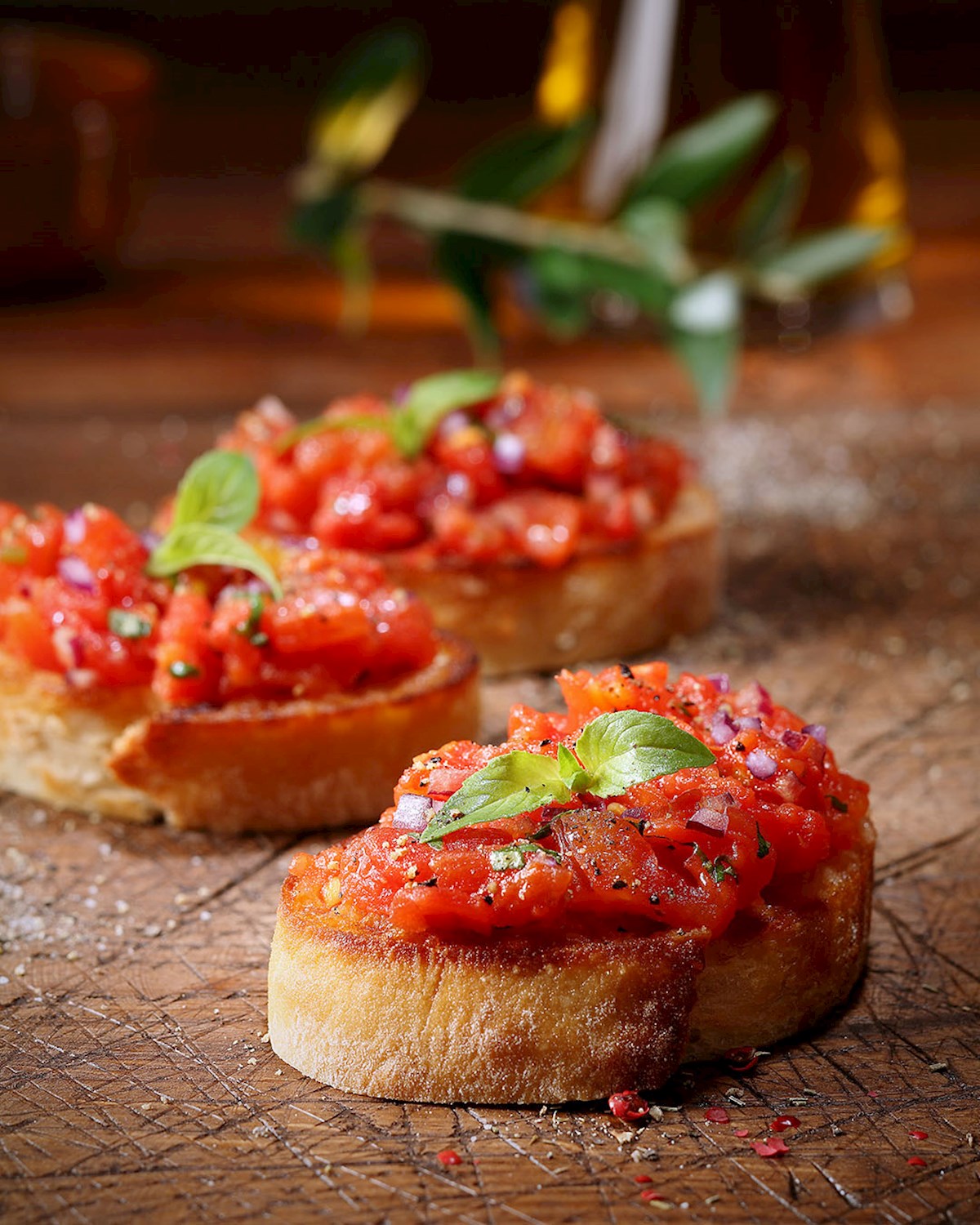 Credits: shutterstock
Credits: shutterstock
Bruschetta al pomodoro is a quintessential Italian antipasto that captures the vibrant flavors of fresh ingredients. It begins with a slice of toasted rustic bread, which serves as a canvas for the topping of juicy tomatoes, fragrant basil, garlic, and a drizzle of extra-virgin olive oil. The simplicity of the dish allows the natural flavors to shine, with the tomatoes' sweetness perfectly complementing the garlic's bite and the basil's aromatic freshness.
TasteAtlas score: 4.3
Learn more about Bruschetta al pomodoro
Baccalà mantecato
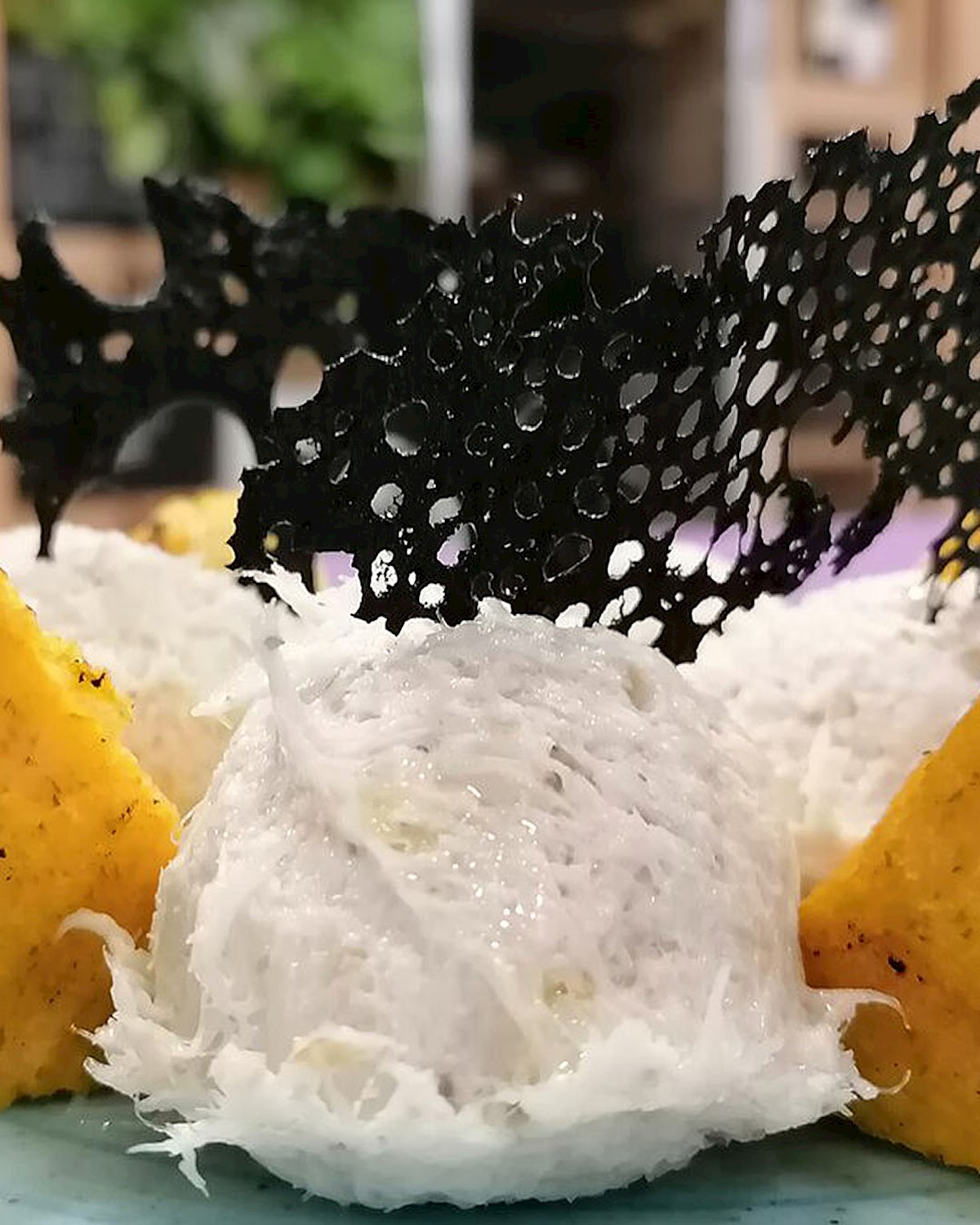 Credits: Orazio 1957
Credits: Orazio 1957
Baccalà mantecato is a classic Venetian dish that showcases the delicate flavors of salted cod, reimagined in a creamy, mousse-like texture. To prepare this delicacy, the cod is soaked to remove excess salt, then cooked and whipped with olive oil until it achieves a rich, smooth consistency. Often flavored with a touch of garlic and lemon, the resulting spread is typically served atop slices of toasted polenta or crusty bread.
TasteAtlas score: 4.1
Learn more about Baccalà mantecato
Sarde in saor
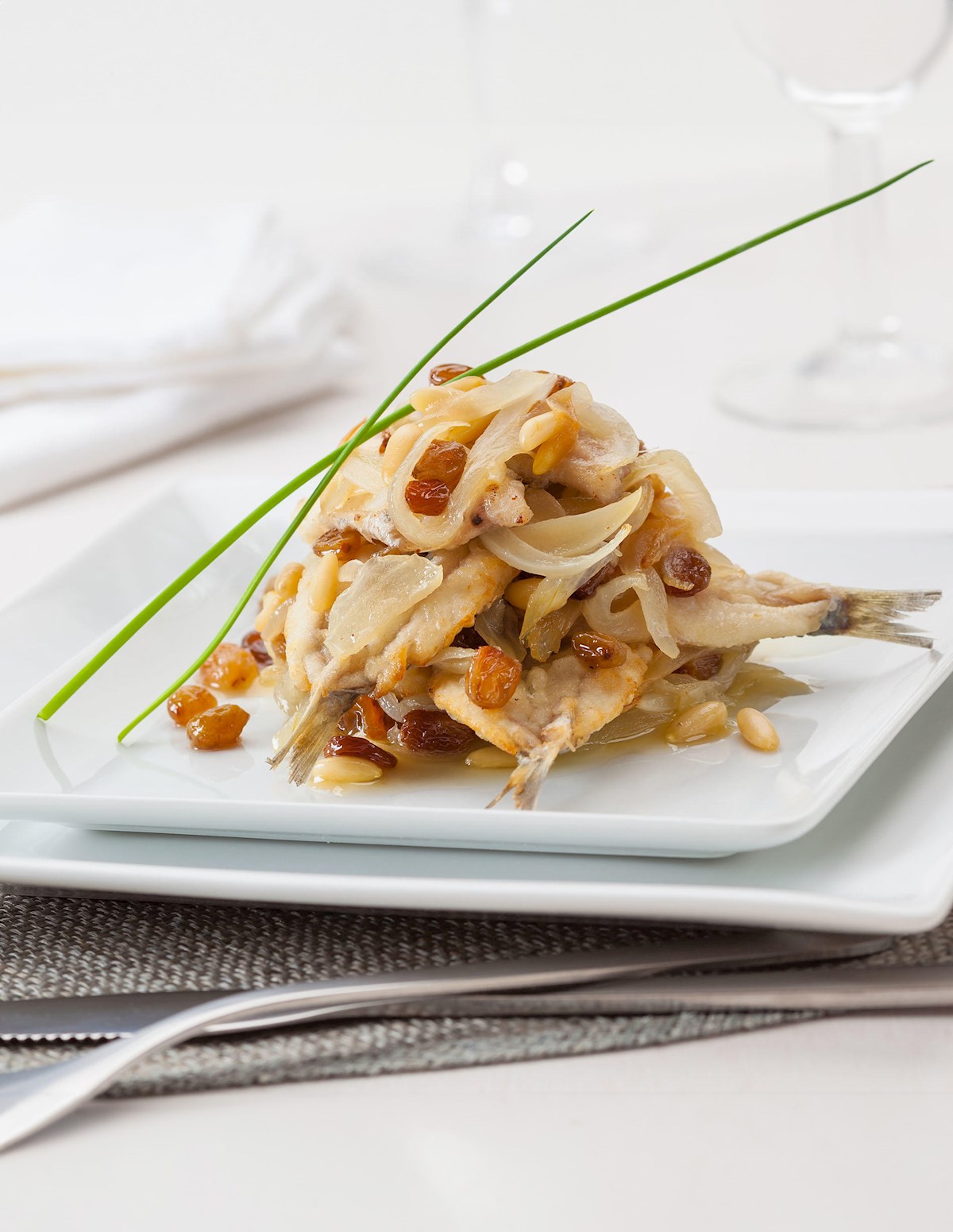 Credits: shutterstock
Credits: shutterstock
Sarde in saor is a traditional Venetian dish, a harmonious blend of culinary simplicity and rich flavors that features sardines which are first fried and then marinated in a mixture of caramelized onions, vinegar, raisins, and pine nuts. Sarde in saor are served cold after marinating for a day or two.
TasteAtlas score: 3.6
Learn more about Sarde in saor
Tramezzino Veneziano
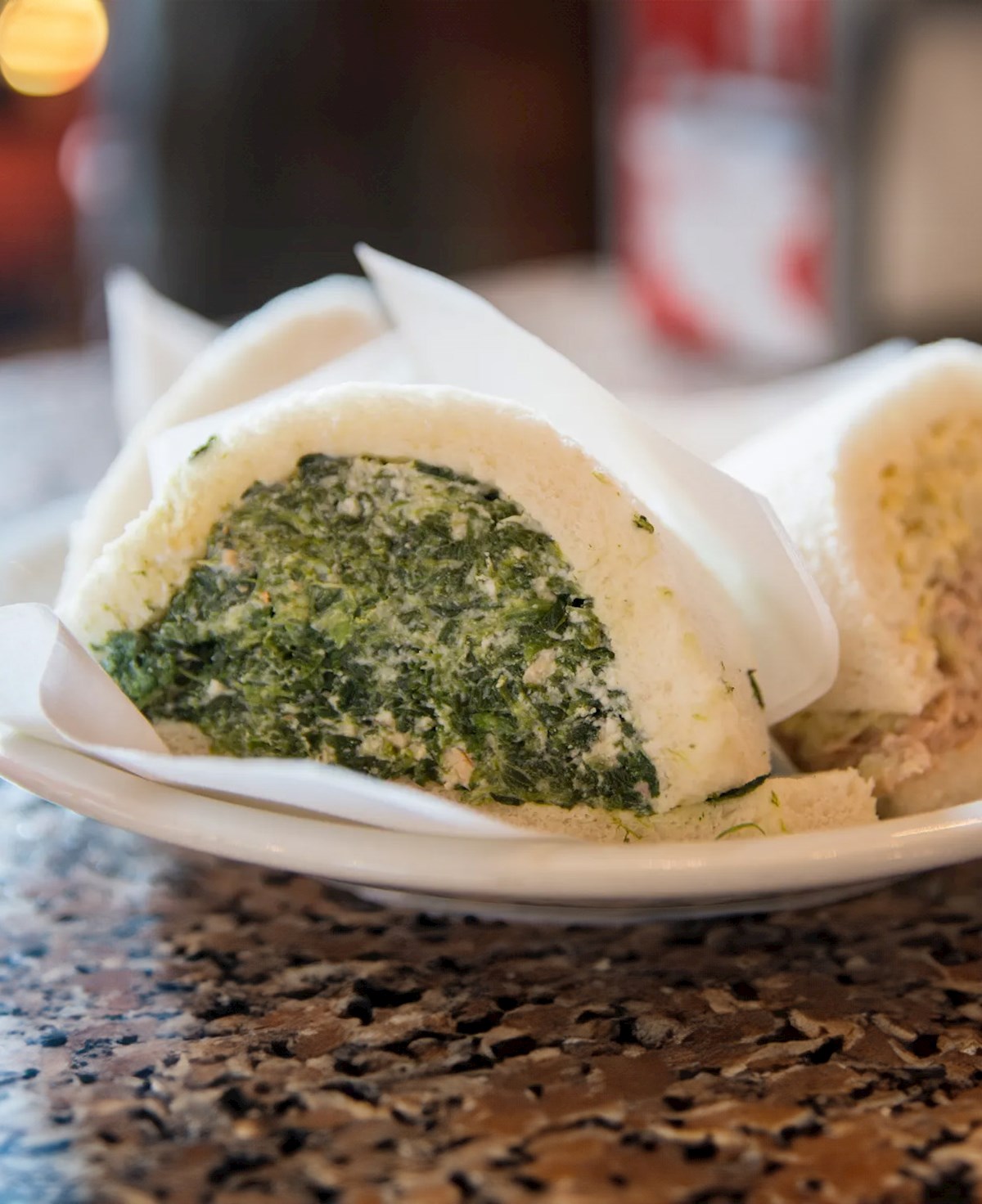 Credits: shutterstock
Credits: shutterstock
These delicate sandwiches, often characterized by their soft white bread devoid of crusts, hide a plethora of fillings ranging from tuna and mayonnaise to chicken, prosciutto, or even artichoke. What sets them apart is not just their shape, but also the quality and combination of ingredients, aiming to provide a balanced, flavorful bite.
TasteAtlas score: 3.3
Learn more about Tramezzino Veneziano
Scampi in saor
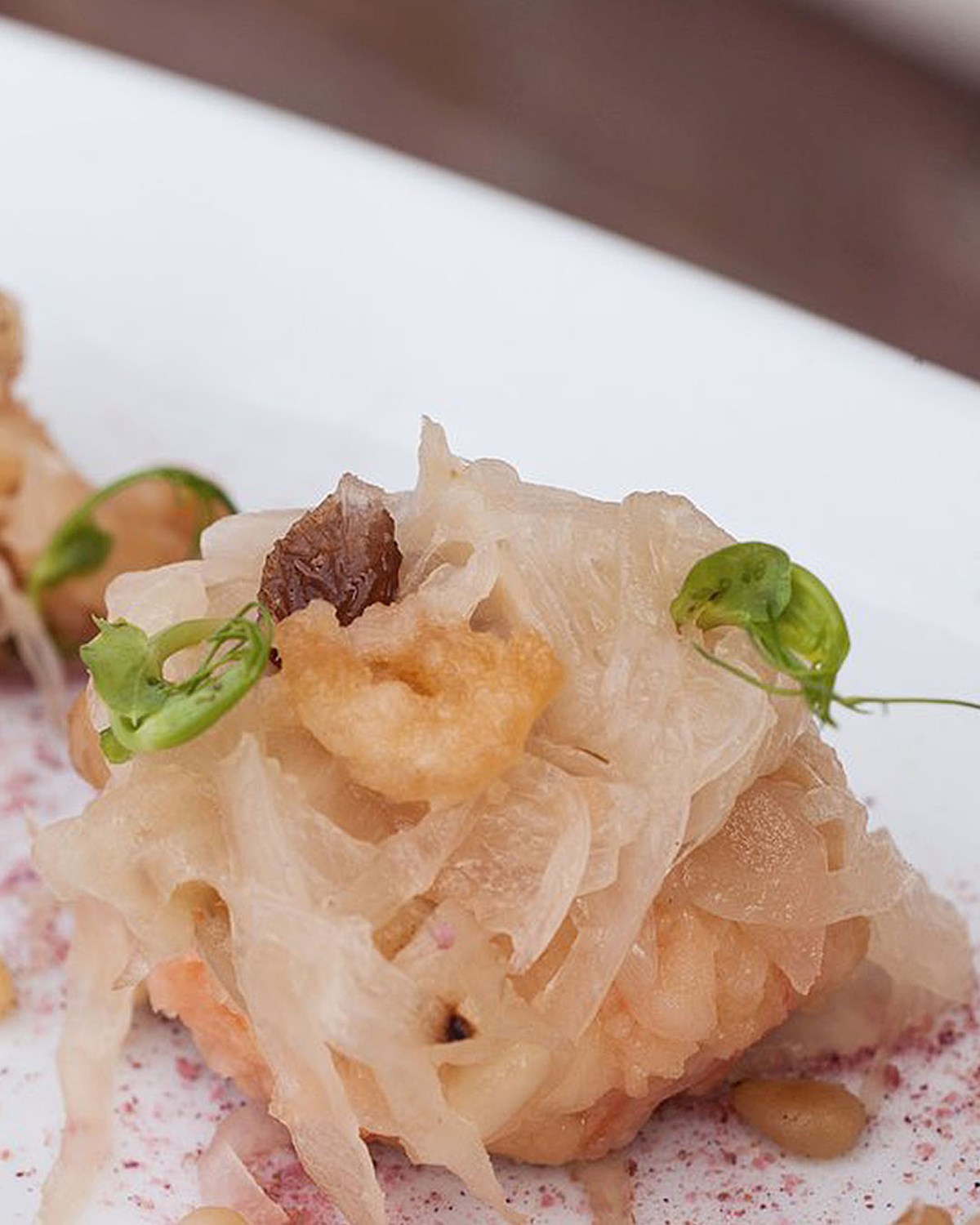 Credits: Antinoo's Lounge & Restaurant
Credits: Antinoo's Lounge & Restaurant
Scampi in saor marries the succulent flavors of scampi, or langoustines, with the traditional Venetian saor marinade. This dish starts with perfectly cooked scampi, which are then combined with a rich blend of caramelized onions, raisins, pine nuts, and vinegar, encapsulating a delightful contrast of sweet, tangy, and sea-infused flavors.
TasteAtlas score: N/A
Learn more about Scampi in saor
Melanzane in saor
 Credits: El Saor - Tradizione Veneta
Credits: El Saor - Tradizione Veneta
Melanzane in saor presents a delightful twist on the traditional Venetian saor technique by showcasing the rich and earthy flavors of eggplant. Instead of seafood, slices or chunks of eggplant are fried until tender and then combined with the characteristic saor marinade of caramelized onions, raisins, pine nuts, and vinegar.
TasteAtlas score: N/A
Learn more about Melanzane in saor
Fondi di carciofo
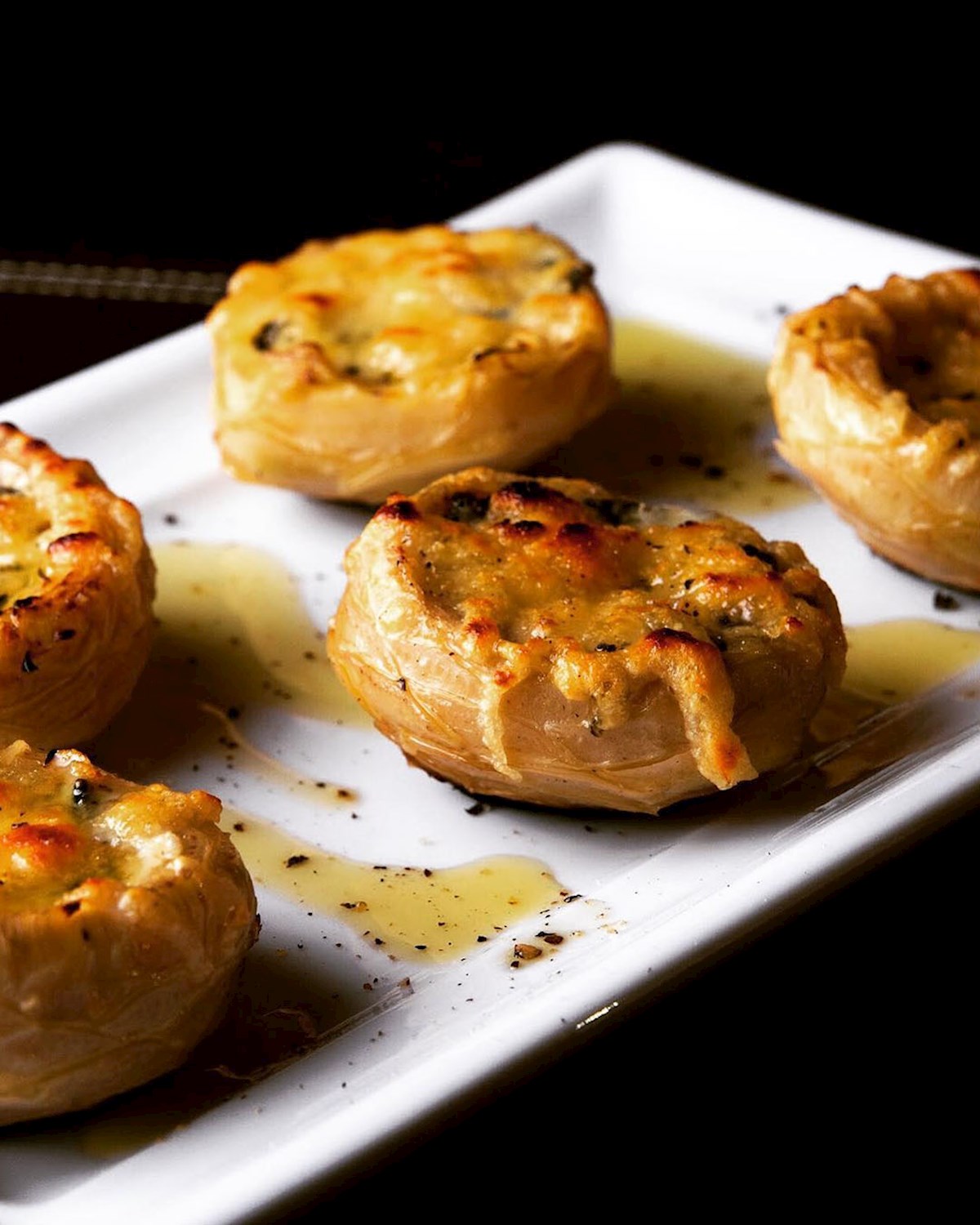 Credits: Donna Florinda Pizzaria Artesanal
Credits: Donna Florinda Pizzaria Artesanal
Fondi di carciofo, or artichoke bottoms, spotlight the tender heart of the artichoke in classic Italian culinary fashion. This dish involves the preparation of the artichoke by removing the tougher outer leaves and trimming the stem, leaving only the succulent base. These artichoke bases can be either steamed, sautéed, or fried, and are frequently seasoned with herbs, garlic, and a splash of lemon to enhance their naturally nutty and earthy flavor.
TasteAtlas score: N/A
Learn more about Fondi di carciofo
